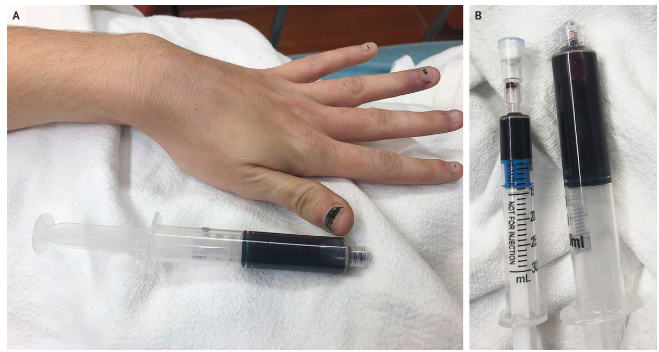A young woman in Rhode Island came to the doctors and said that she was “blue,” and she meant it literally. Doctors analysed her physically and they were able to see the bluish coloration of her skin. When doctors drew blood from the patient’s arteries, it appeared dark blue instead of the normal bright red.
A 25-year-old woman presented to the emergency department with a 1-day history of generalized weakness, fatigue, shortness of breath, and skin discoloration.
On examination:
- She had a respiratory rate of 22 breaths per minute and an oxygen saturation of 88% while breathing ambient air.
- The oxygen saturation value displayed on the pulse oximeter did not improve with the administration of supplemental oxygen.
- The patient appeared cyanotic (Panel A), and she had dark arterial and venous blood (Panel B, smaller tube and larger tube, respectively).
- Measurements of arterial blood gases included a partial pressure of arterial oxygen of 120 mm Hg and a calculated oxygen saturation of 100%.
- The percentage of methemoglobin was 44%.

After thorough examination, she was diagnosed with Methemoglobinemia. The condition can cause bluish skin and blood.
She was treated with intravenous methylene blue and had considerable improvement in her breathing and reduction in skin discoloration.
She reported having used large amounts of topical benzocaine the night before for a toothache. Thus, it could be a reaction to her medicine.
Methemoglobinemia can occur after exposure to a number of medications, including topical anesthetic agents such as benzocaine. It could be an inherited metabolic disorder.
Reference
Warren OU, Blackwood B. Acquired Methemoglobinemia. New England Journal of Medicine. 2019 Sep 19;381(12):1158-.







